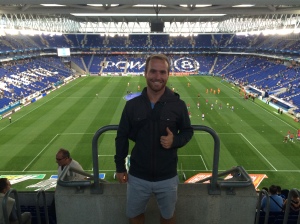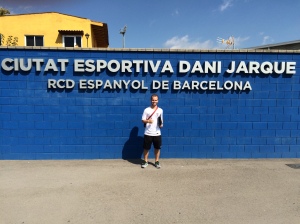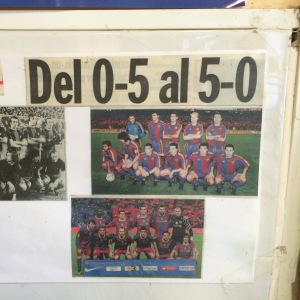Hello again, and welcome back to Barcelona, Spain!
In this edition, I will discuss the #10 position in addition to sharing our second sport psychology session with Xavi Garcia.
Let’s get started.
In order to best describe the #10 position (offensive midfielder), I want to start with this video.
When we began the lesson on the #10, Dr. Rude explained to us that depending on the coach’s system of play, there could be 1, 2, or 3 #10s. Normally, the #10(s) look to exploit the space between the midfield and defensive lines.
The #10 IFP
Offensive Blocks
- Offering Support
- Side balls/Crossing
Defensive Blocks
- Defending the Space
As you can see, compared to the other positions that we discussed, the #10 role seems simple and basic. However, I can assure you that it is not. Allow me to further explain.
Within the block of ‘offering support’, one fundamental states “offering support between the opposing midfield and defensive lines”. By occupying the space between those two lines, the #10(s) have the ability to create space for the other midfielders in addition to creating space for the striker(s). Dr. Rude explained to us that occupying such position causes difficulties for the opponent because the midfield line has to defend the space that is behind them while the defenders do not want to step to mark the player as defensive imbalances can/will occur.
For a visual explanation, take a look at the video below. It is a highlight video of the FC Barcelona – Real Madrid game from 2009. When you press play, pause the video at exactly the 6-second mark. With the video paused, pay particular attention to the shape of Real Madrid (team in white), as you will notice their defensive line is a ‘zigzag’ shape. Now ask yourself, why is their defensive ‘line’ in a zigzag form? Notice the positioning of FCB’s center-forward (left corner of the screen) and the positioning of Lionel Messi (the FCB player near the midfield center circle – the closest attacker supporting the on-ball player). Due to Messi’s positioning, the Real Madrid center-back is forced to leave his defensive position to mark Messi (who is occupying the space between Madrid’s midfield and defensive lines), leaving a massive gap for the FCB striker to potentially exploit. Strategic offensive positioning causes defensive imbalances!
To transition, on Friday, MBP went on a field trip to visit with Xavi Garcia for our second sport psychology lesson. The lesson was not only theoretical in terms learning the specifics of communication, listening, and leadership, but we were also able to experiment with different leadership styles in a real setting.
Before I go further, I think it is important to better describe Xavi’s garden. Imagine an environment that is complete ‘Zen’. When you enter the garden, you immediately become curious and relaxed simultaneously. Prior to departing to Xavi’s house in Manresa (center of Catalonia – about a 1 hour train ride from Barcelona), Dr. Rude told us that in order for Xavi’s lesson to operate, it must take place in his garden. Not long after arriving to Xavi’s, we all realized what Dr. Rude was telling us. The garden was filled with a swimming pool, a hammock, a meditation area, a fish tank, and a heated central patio area with comfortable chairs and coffee!
One objective of Xavi’s lesson was for us to experiment with different leadership styles in order to better understand ourselves as coaches. One exercise included us having to order around another coach like a puppet. Very simply, the ‘puppet master’ commanded the puppet to do anything that came to mind. The goal for the puppet master was to get the puppet to say “no I cannot do that”. For instance, when I was the puppet, I was commanded to count rocks, do a cartwheel, and try to touch the fish in the fish tank.
The second exercise pertained to the idea of ‘leading by example’. Essentially, each one of us took turns leading the group through anything we wanted, but the leader had to initiate the actions. For instance, when Jesus was leading the group, he began climbing a tree, and immediately the rest of us found a tree to climb. However, if one of us did not feel comfortable completing the action, we simply could say, “I cannot do it”. For the most part, all of us were able to complete the actions. However, things slightly changed when a coach decided to lead us until the pool. Slowly but surely, we began to enter the frigid pool. The first 2 coaches to follow leader entered slowly, and when it was my turn, I let my presence be felt by doing a cannon ball. However, due to an ethical agreement, I cannot say who did not join us for a swim!
Throughout the entire session, we shared many laughs and learned a great deal of information from Xavi and ourselves. In particular, I realized that I cannot operate as a ‘puppet master’. Ordering Rik around Xavi’s garden was more of a challenge for me than it was for Rik. However, when it was my turn to lead the group by example, I felt at peace knowing that I was going to have the same experiences as the ‘players’.
Week 6 was an integral segment of our learning because we were able to discover which leadership/communication techniques work best for us as individuals. A coach can have all the insight and knowledge in the world, but if they cannot effectively communicate to their players, their expertise goes to waste.
On a side note, we did not attend any games this weekend due to the international break, and I was lucky enough to go explore/tour the famous Sagrada Familia. I have attached some pictures to check out. The history and design of the cathedral is truly remarkable!
Thanks for reading and I look forward to sharing my experiences from Week 7!
Also, I am in the midst of launching a new TOG Soccer website. There is a good chance the next post will be embedded in the new design. As usual, the link to the post will be posted on Twitter, Facebook, and LinkedIn.
Brett Uttley
Twitter: @BrettUttley & @TOGSoccer

















